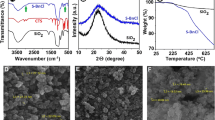Abstract
A two-stage process has been developed to generate the silica-based macromonomer through surface-modification of silica with polymerizable vinyl groups. The silica surfaces were treated with excess 2,4-toluene diisocynate (TDI), after which the residual isocyanate groups were converted into polymerizable vinyl groups by reaction with hydroxypropylacrylate (HPA). Thus, polystyrene/silica nanocomposites were prepared by conventional radical copolymerization of styrene with silica macromonomer. The main effecting factors, such as ratios of styrene to the macromonomer, together with polymerization time on the copolymerization were studied in detail. FTIR, DSC and TGA were utilized to characterize the nanocomposites. Experimental results revealed that the silica nanoparticles act as cross-linking points in the polystytene/silica nanocomposites, and the glass transition temperatures of the nanocomposites are higher than that of the corresponding pure polystyrene. The glass transition temperatures of nanocomposites increased with the increasing of silica contents, which were further ascertained by DSC.
Similar content being viewed by others
References
Tang B Z, Geng Y, Lam J W Y, Li B, Jing X, Wang X, Wang F, Pakhomov A B, Zhang X X. Processible nanostructured materials with electrical conductivity and magnetic susceptibility: preparation and properties of maghemite/polyaniline nanocomposite milms. Chem Mater, 1999, 11(6): 1581–1589
Jing Xinli, Zheng Maosheng, Jin Zhihao, Xu Xiaolin. Study on praperation and proterpies of PMMA-SiO2 in-situ composites. Polymer Materials Science and Engineering (in Chinese), 1998, 14(4):62–64
Collins D E, Slamovich E B. Preparation of a homogeneously dispersed BaTiO3/polymer nanocomposite thin film. Chem Mater, 1999, 11(9): 2319–2321
Sanchez C, Soler-Illia G J A A, Ribot F, Lalot T, Mayer C R, Cabuil V. Designed hybrid organic-inorganic nanocomposites from functional nanobuilding blocks. Chem Mater, 2001, 13(10): 3061–3083
Schottner G. Hybrid sol-gel-derived polymers: applications of multifunctional materials. Chem Mater, 2001, 13(10): 3422–3435
Pyun J, Matyjaszewski K. Synthesis of nanocomposite organic/inorganic hybrid materials using controlled/“living” radical polymerization. Chem Mater, 2001, 13(10): 3436–3448
Francoise S, Thanh M L, Jean P P, Christian M. Organic-inorganic hybrid materials. 2. Compared structures of polydimethylsiloxane and hydrogenated polybutadiene based creamers. Macromolecules, 1992, 25(21): 5742–5751
Jeng R J, Chen Y M, Chen J I, Kumar J, Tripathy S K. Phenoxysilicon polymer with stable second-order optical nonlinearity. Macromolecules, 1993, 26(10): 2530–2534
Landry C J T, Coltrain B K, Landry M R, Fitzgerald J J, Long V K. Poly(vinyl acetate)/silica-filled materials: Material properties of in situ vs fumed silica particles. Macromolecules, 1993, 26(14): 3702–3712
Wu S G, Ellerby L M, Cohan J S, Dunn B, El S M A, Valentine J S, Zink J I. Bacteriorhodopsin encapsulated in transparent sol-gel glass: a new biomaterial. Chem Mater, 1993, 5(1): 115–120
Huang Zhihua, Qiu Kunyuan. Poly(methyl methacrylate)/TiO2 hybrid polymer materials prepared by the sol-gel process. Chem J Chin U (in Chinese), 1997, 18(5): 803–806
Zhang Yonghua, Gong Kecheng. Advances in organic-inorganic nanocomposites prepared via sol-gel process. Polym Mater Sci Eng (in Chinese), 1997, 13(4): 14–18
Cao Lixin, Yuan Xundao, Wan Haibao, Zeng Guangfu, Xi Shiquan. Preparation of inorganic-organic nanocomposite materials by sol-gel process. Chin J Appl Chem (in Chinese). 1998, 15(3): 1–5
Prucker O, Ruhe J. Synthesis of poly(styrene) monolayers attached to high surface area silica gels through self-assembled monolayers of azo initiators. Macromolecules, 1998, 31(3): 592–601
von Werne T, Patten T E. Atom transfer radical polymerization from nanoparticles: A tool for the preparation of well-defined hybrid nanostructures and for understanding the chemistry of controlled/“living” radical polymerizations from surfaces. J Am Chem Soc, 2001, 123(31): 7497–7505
Michiel L C M O, Arjen S, Arend J S. Anionic grafting of polystyrene and poly(styrene-block-isoprene) onto microparticulate silica and glass slides. Polymer, 1992, 33(20): 4394–4400
Espiard P, Guyot A. Poly(ethyl acrylate) latexes encapsulating nanoparticles of silica. 2. Grafting process onto silica. Polymer, 1995, 36(23): 4391–4395
Jethmalani J M, Ford W T. Diffraction of visible light by ordered monodisperse silica-poly(methyl acrylate) composite films. Chem Mater, 1996, 8(8): 2138–2146
Li Shaoxiong, Liu Yijun. Polyurethane Adhesive (in Chinese). 1st ed. Beijing: Chemical Industry Press, 1998. 13–15
Boven G, Michiel L C M O, Challa G, Arend J S. Grafting kinetics of poly(methyl methacrylate) on microparticulate silica. Polymer, 1990, 31(12): 2377–2383
Li H R, Lin J, Zhang H J, Fu L S, Meng Q G, Wang S B. Preparation and luminescence properties of hybrid materials containing europium (III) complexes covalently bonded to a silica matrix. Chem Mater, 2002, 14(9): 3651–3655
Ke Yikan, Dong Huiru. Analysis Chemistry Handbook-spectra Analysis (in Chinese). 2nd ed. Beijing: Chemistry Industry Press, 1998. 957
Gao Qibiao. In-situ Polymerization of Styrene/Nano-SiO2 (in Chinese). Dissertation for Master Degree. Hangzhou: Zhejiang University, 2002. 18–64
Bartholome C, Beyou E, Bourgeat L E, Chaumont P, Zydowicz N. Nitroxide-mediated polymerizations from silica nanoparticle surfaces: “Graft from” polymerization of styrene using a triethoxysilyl-terminated alkoxyamine initiator. Macromolecules, 2003, 36(21): 7946–7952
Shang X Y, Zhu Z K, Yin J, Ma X D. Compatibility of soluble polyimide/silica hybrids induced by a coupling agent. Chem Mater, 2002, 14(1): 71–77
Author information
Authors and Affiliations
Corresponding author
Rights and permissions
About this article
Cite this article
Ou, B., Li, D. Preparation of polystyrene/silica nanocomposites by radical copolymerization of styrene with silica macromonomer. SCI CHINA SER B 50, 385–391 (2007). https://doi.org/10.1007/s11426-007-0069-x
Received:
Accepted:
Issue Date:
DOI: https://doi.org/10.1007/s11426-007-0069-x




